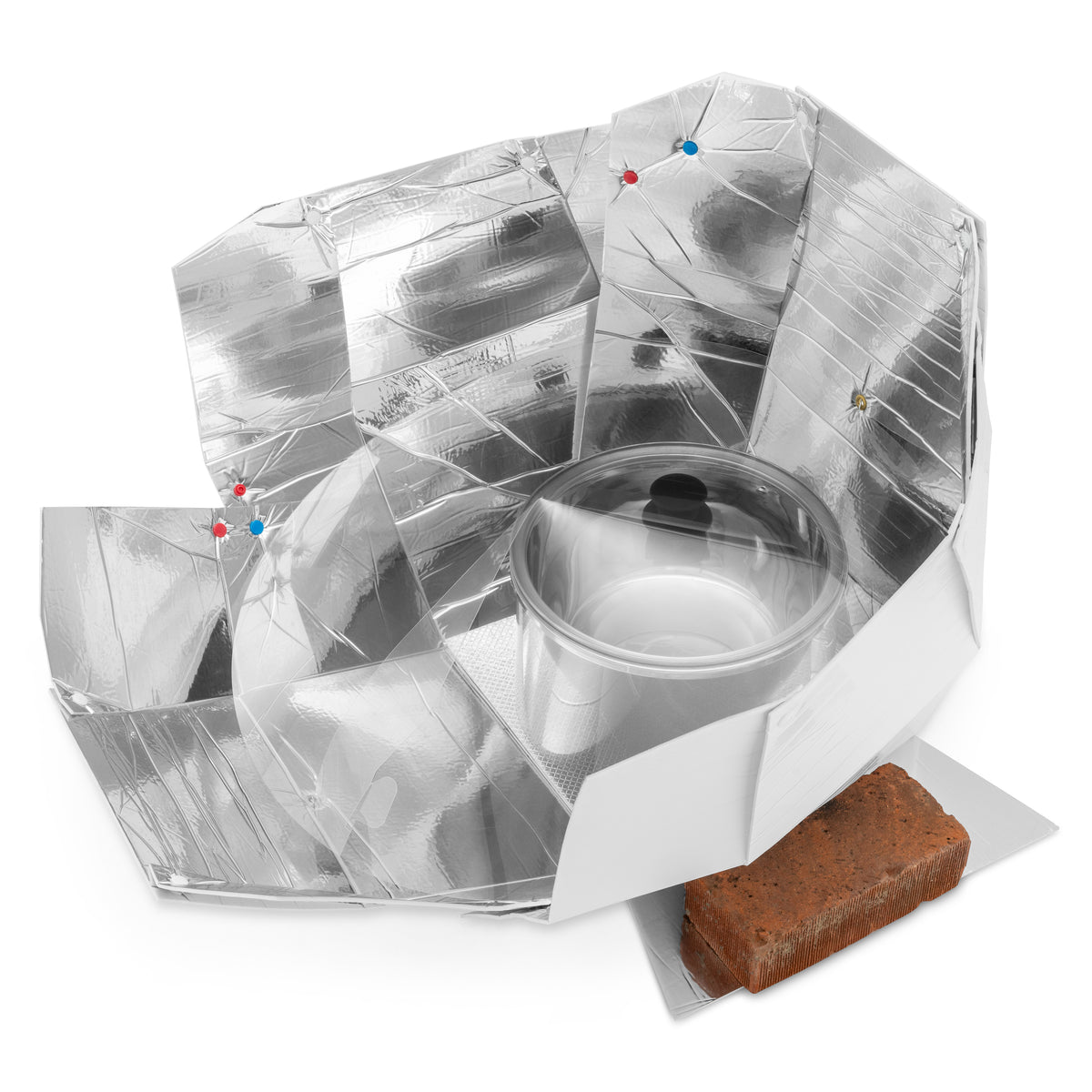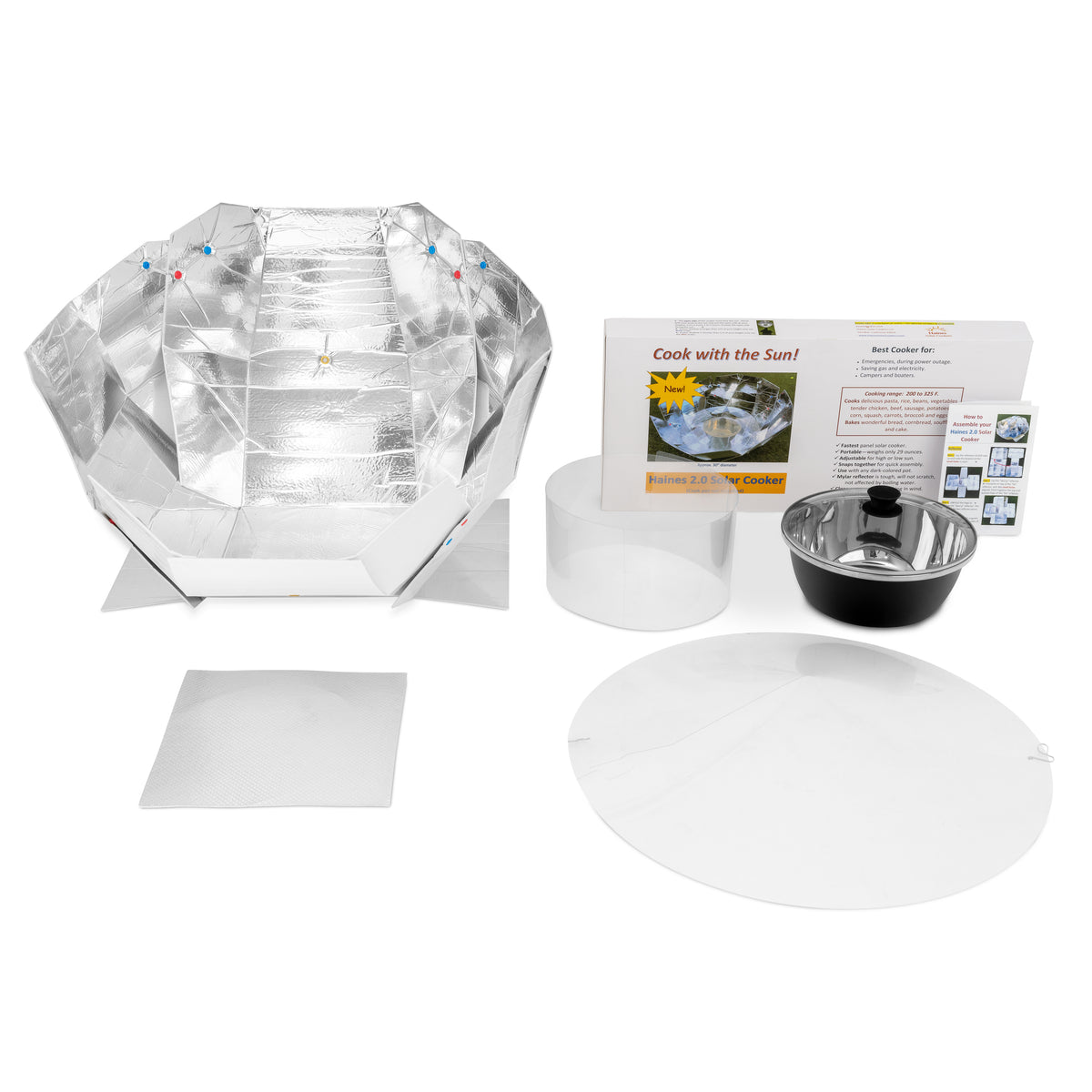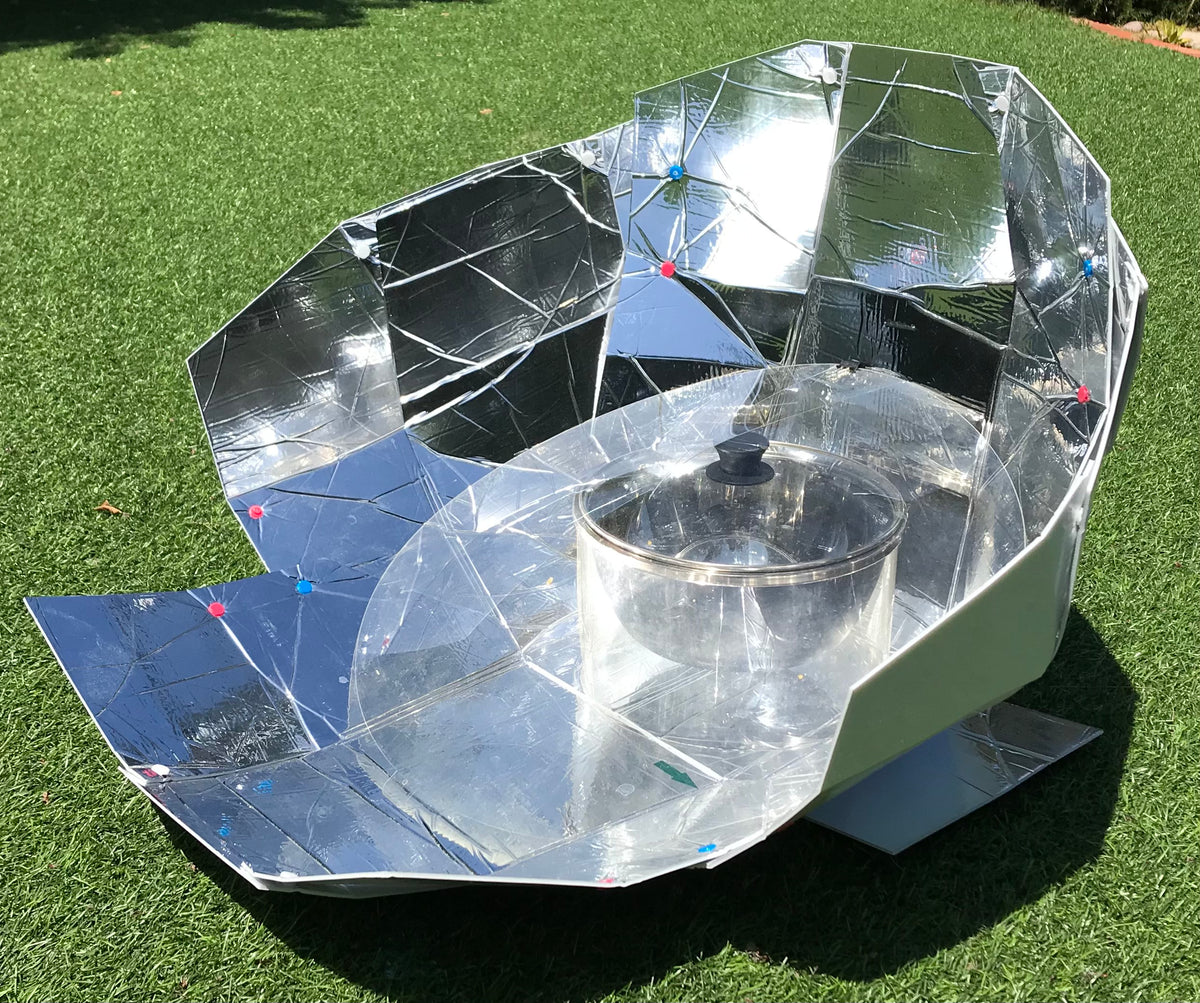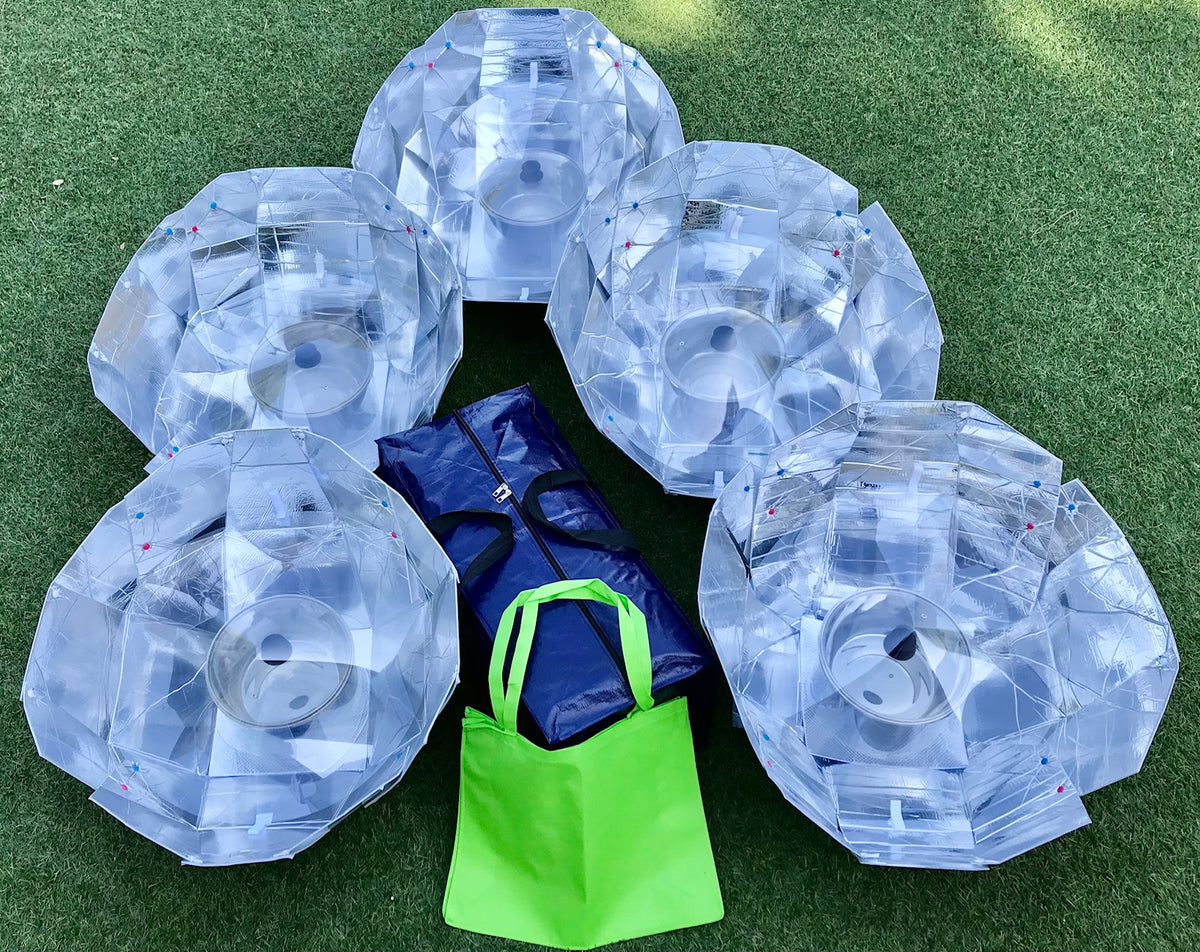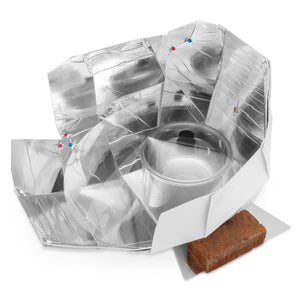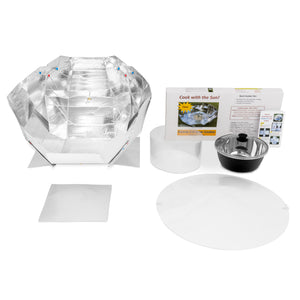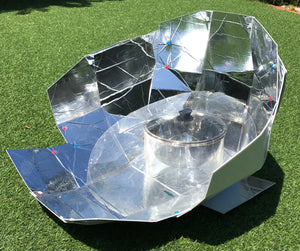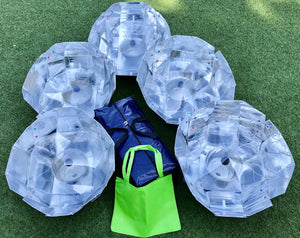Empowering Women in Mexico
May 15, 2021
This powerful video is a testimony of how Haines solar cookers have improved lives in a rural Mexico community. It details how households, restaurants and even commercial facilities use the power of the sun to cook, bake and process materials. Users save money, and improve the health of the community
Solar cooker manufacturers Sharon Claussen (Copenhagen Solar Cooker) and Roger Haines (Haines Solar Cookers) have teamed up to make polycarbonate face shields for health care workers. Roger provides the polycarbonate sheets, and Sharon and her husband Glenn make the shields using a 3D printer. See photo below.

We will be able to make around 700-800 face shields, and so far have delivered over a hundred tograteful medical personnel. Many more have been requested, including 200 for Family Health Centers San Diego. Sharon is also working with a couple groups making face masks.
Haines Solar Cookers in Haiti
In late 2019, The Public-Private Alliance Foundation shipped 20 Haines 1.0 solar cookers to Hinche, Haiti, and is training women in how to assemble and use them. The cookers are part of multi-dimensional training program at the University of Notre Dame in Hinche.
At the end of the class, the students were asked to fill out a questionnaire about what they had cooked, and whether they were likely to continue using the cooker. Their responses were overwhelmingly enthusiastic, with many saying they would use the cooker “for life.”

Haines 2.0 Solar Cookers for Refugees in Uganda
In late January 2020, 33 women in the Palabek Refugee Community in northern Uganda received Haines 2.0 Solar Cookers and were extensively trained in how to use them. The project was organized by the Gulu-based Alliance for African Assistance in partnership with the African Refugee Education Project, the San Diego Rotary Club, Solar Household Energy and the Solar Connect Association of Uganda. The goal is to establish 33 women in the community as long-term solar cooking enthusiasts. Three of the women will be selected by their peers as to conduct periodic surveys to evaluate the long term use and adoption of the cookers, and the possibility of establishing a sustainable solar cooker enterprise in the community.
Haines Solar Cookers in Oaxaca, Mexico
Learn how Haines Solar Cookers are making an impact in Oaxaca, Mexico. Sponsored by Solar Household Energy, women from 10 communities have received ~200 solar cookers, including residents of the municipality of Villa de Zaachila, which has about 43,000 inhabitants.
Watch the video to learn more...
The Ambassador-Led Social Enterprise in Oaxaca, Mexico
Cocineros Solares
Solar Household Energy
Download this brochure as a PDF


Blog
Haines 2 Solar Cookers in The Gambia
Haines 2 Heats Twice as Fast as Popular “CooKit” solar cooker
At noon on June 30, 2019, we conducted a side-by side test of a Haines 1 and a Haines 2 Solar Cooker along with two popular “CooKit” solar cookers. The four cookers were set up on a single piece of cardboard in the shade. The sun was about 80 degrees directly overhead. The sky was clear and there was an occasional breeze. The ambient temperature was around 86 F. (30 C.) throughout the test (as shown by the bold line at the bottom of the graph below).
The pots in each cooker were identical 4 ½ liter stainless steel Haines Dutch ovens with glass lids. Each pot had one liter of water taken from a common bucket. The two Haines cookers and one CooKit used a Haines cooking sleeve and circular cover. [Note: the cover did not fit the CooKit very well.] The other CooKit enclosed the pot in it recommended plastic cooking bag, on a 1-inch-high wooden trivet. Both CooKits were set for high sun, with the front flap up as high as it would go. The Haines 2 was set for high sun (red snaps). The Haines 1 was not adjusted in any way.
A thermocouple wire was inserted through the steam vent in each glass lid, into the water. The wires were connected to a HOBO Onset 4-channel thermocouple logger. The logger was started at 12:21 p.m., and the cardboard with the four cookers on it was pulled into the sun.

Observations: As shown on the graph below, the Haines 2 boiled the water in 48 minutes, followed by the Haines 1 in 65 minutes, the CooKit with the Haines cooking sleeve and circular cover in 86 minutes, and the CooKit with the plastic bag in 100 minutes. The cardboard was turned four times during the test, to follow the sun. We noted that below 40C., the CooKit withthe circular cover heated more slowly than the Cooker withoutthe circular cover. But above 40 C. the CooKit with the cover heated faster—apparently because the cover retained more heat than it blocked at temperatures above 40 C. This confirms earlier tests that showed similar results. Thus it appears that the performance of the CooKit can be improved by replacing the plastic bag with a Haines Cooking sleeve and circular cover. However, even with these improvements, the CooKit took 21 minutes longer than the Haines 1 to boil the water.

Conclusion: When the sun is high in the sky, the Haines 2 can boil a liter of water in under 50 minutes—more than twice as fast as the CooKit with a plastic cooking bag. Under the same conditions, the Haines 1 can boil a liter of water in 65 minutes, i.e., in only 65 percent of the 100 minutes it takes for the CooKit with a plastic bag.
Other Tests
We have found side-by-side testing to be the best method for determining the performance of solar cooking designs. Indeed this is the method we have used to perfect the Haines 1 and Haines 2 designs. Over the years, we have performed similar side-by-side tests comparing the Haines 1 or 2 to all the leading panel and box cookers, at all times of the day. No other cooker has exceeded the performance of the Haines models, and many of them failed even to reach cooking temperatures, on days when the Haines cookers boiled the water. These photos show some of the cookers we have tested.
Haitian university students study Haines Solar Cookers
David Stillman sent this photo of the first use of two Haines 2.0 “SunUp” Solar Cookers that Rose Bazile recently brought to the Universite Notre Dame d’Haiti at Hinche. Check out the lab coats and the Medical Biology shirt among the students. The cookers will be used in the first-ever college course in Haiti on the subject of Biogas and Solar Stoves.
Haines Solar Cookers at the Kakuma Refugee Camp in Kenya
On April 29, Haines Solar Cookers and our partners in Kenya, India, and the San Diego Rotary Club, distributed 500 Haines-Copenhagen Solar Cookers in Kakuma refugee camp, Kenya. This video was made by Nairobi Television station KTV. The cookers used the same reflective material and cooking sleeve as the regular Haines Solar Cooker, without the polycarbonate cover.
Haines Solar Cookers for Haiti
In October, 2016, for his Eagle Scout project, Russell Desrosier of Fairfax, Virginia, arranged for his Boy Scout troop to build 36 Haines Solar Cookers for Haiti. In the group photo, Russell in the one in the funny hat made from a circular cover. Russell plans to deliver the cookers in January 2017 to recipients in Haiti as part of a project organized by WeCareToShare, Chantal, a medical-dental relief team that has been working in Chantal, Haiti since the 2010 earthquake. Chantal is a rural rice-farming village approximately 250 km from Port Au Prince on the Tiburon Peninsula. The team obtained a grant from Rotary District 7610 to improve a kitchen at one of the Chantal schools with almost 900 K – 12 students. The group has been consulting with solar cooking experts Mary Buchenic and Sharon Cousins, and plans an intensive one week workshop on solar cooking for the village. They’ll be teaching the school cooks to use solar cooking as well as teaching adults from the village.
Haines Solar Cookers in Gaga Refugee Camp

In March, 2016, a contractor tested Haines Solar Cookers in the Gaga Refugee Camp in Chad, and found that they outperformed the other solar cookers tested, and that a focus group in the camp preferred the Haines over the others. Accordingly, the contractor recommended the Haines Cooker for use by the UN High Commissioner for Refugees. The contractor’s field tests confirmed that the Haines Cooker cooks faster than the other cookers tested, and that it was more convenient to use.
For many years, NGOs have funded the distribution of cardboard “CooKit” solar cookers in the Gaga Camp. But this project has ended, and the U.N. is phasing out free distribution of wood, so there is an even greater need for solar cookers. As a result, we are seeking funding to get Haines Solar Cookers into Gaga and other refugee camps. Consistent with the UN’s new “entrepreneurial model,” outside funding would allow us to offer Haines Solar Cookers in the camps at “market” (i.e., subsidized) prices.
Blog
Haines Solar Cookers in Kisumu, Kenya
 On May 14, 2016, Camily Wedende of Eldoret, Kenya, obtained six Haines Solar Cookers from Dinah Chiengo in Lower Nyakach, Kenya, and provided a solar cooking demonstration to a group of educators in Kisumu, Kenya. It was a very sunny day and the educators were very happy and amazed to see some meat, ugali, and green vegetables cooked in the sun. They tested the food and found that it was well cooked, and expressed interest in purchasing the cookers for $40 (4,000 KSh) each. Camily is actively promoting Haines Solar Coolers through his business, Sun Cookers International, in Eldoret.
On May 14, 2016, Camily Wedende of Eldoret, Kenya, obtained six Haines Solar Cookers from Dinah Chiengo in Lower Nyakach, Kenya, and provided a solar cooking demonstration to a group of educators in Kisumu, Kenya. It was a very sunny day and the educators were very happy and amazed to see some meat, ugali, and green vegetables cooked in the sun. They tested the food and found that it was well cooked, and expressed interest in purchasing the cookers for $40 (4,000 KSh) each. Camily is actively promoting Haines Solar Coolers through his business, Sun Cookers International, in Eldoret.
Haines Solar Cookers in Uganda
On April 11 and 12, 2016, Roger Haines traveled to Africa and met with women in villages near Gulu and Atiak, Uganda. He wanted to observe how they were using 500 Haines Solar Cookers that had been distributed by the Gulu, Uganda Rotary Club. The women were asked to bring their cookers to the village center and set them in the sun to cook.
Roger was welcomed with dancing and singing, and the women were invited to say what they liked about the cooker, and what they disliked about it. Many said they were surprised that it could cook their traditional foods, including ugali, without stirring. Ugali is maize meal, and tastes like stiff Cream of Wheat. One disabled woman said what a blessing it was that she did not have to ask others to collect firewood for her. The only “dislike” was that they could not cook at night.

Rotaract members make WAPIs for solar cookers
On February 13, 2016, about 40 young people from San Diego Rotaract Clubs spent their Saturday at UCSD making almost 1,000 Water Pasteurization Indicators (WAPIs), for solar cooker projects in East Africa. These simple, reusable devices use a short plastic tube with wax that melts at pasteurization temperature (about 66 C.) to show when water is safe to drink. Because they eliminate the need to heat water to boiling, they permit twice as much water to be pasteurized in a day. Roger Haines made a presentation about Rotary’s Solar Cooker Project in Gulu, Uganda, Five hundred of the WAPIs will be given away with the Haines Solar Cookers that will be distributed in March-April, 2016.

Gulu, Uganda – Training for distribution of Haines Solar Cookers
On February 1, 2016, Camily Wedende of Sun Cookers International in Eldoret, Kenya, put on a “train the trainer” program in preparation for the Gulu, Uganda, Rotary Club’s distribution of 500 Haines Solar Cookers in Northern Uganda. Geoffrey Okello of the Gulu Rotary Club reported that the group benefited greatly from Mr. Wedende’s solar cooking knowledge and experience and above all learned how to cook African staple foods in a solar cooker.
To cook Posho (Ugali), the flour needs to be mixed with cold water and covered, instead of the normal way of first boiling the water before adding the flour, and no stirring is required. Sweet potatoes and cassava need to be cut into small pieces, eggs have to be placed directly on the solar cooker instead of the normal way of boiling in water.
The group made and drank tea before cooking the following food items for lunch: Sweet potatoes, Rice, Green vegetables, Eggs and Posho (Ugali). They also cooked beans but they weren’t quite done by closure time of the training.
Attached are some pictures taken during the training.










































